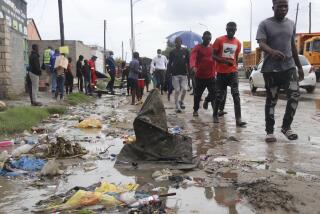Second strain of cholera identified in Haiti epidemic
- Share via
U.S. researchers have linked a second strain of cholera to the epidemic that decimated the Haitian population in 2010-11. Previous studies have suggested that the epidemic was caused by bacteria inadvertently introduced by Nepalese soldiers who came to assist in recovery from a massive earthquake. The new strain appears to be local in origin, but its role in the epidemic is not clear because this strain does not normally produce epidemics.
Haiti suffered a devastating magnitude 7 earthquake on Jan. 12, 2010, followed by about 52 aftershocks with a magnitude of 4.5 or higher. Estimates indicate that more than 250,000 died immediately, about 300,000 were injured and 1 million were rendered homeless. Cholera cases began to appear in October and the spread of the disease was exacerbated by Hurricane Tomas, which skirted the island on Nov. 5 but produced torrential rains and severe flooding. To date, cholera has killed an estimated 7,500 Haitians and sickened half a million.
Early studies by the U.S. Centers for Disease Control and other researchers showed that the primary cause of the epidemic was a bacterium known as Vibrio cholerae 01, which is found primarily in Asia. Many researchers speculated that the strain was brought to the island by Nepalese soldiers sent to provide relief, but none of the soldiers is known to have suffered cholera before arriving in Haiti.
A team headed by geneticists Claire M. Fraser-Liggett and Rita R. Colwell of the University of Maryland in College Park collected fecal samples from 81 cholera victims in 18 Haitian towns in November 2010, early in the outbreak. The team then sequenced the cholera bacterium in 76 of the samples. They reported Monday in the Proceedings of the National Academy of Sciences that 47 of the samples contained the V. cholerae 01 strain that is thought to be the cause of the epidemic. But 29 of them contained only strains known as V. cholerae non-01/0139.
The latter strains of the bacterium are found routinely in waterways and estuaries in the western hemisphere. They produce diarrhea but are not thought to be capable of causing an epidemic. But because so many of the patients carried the supposedly non-epidemic strain, the researchers concluded, it must be able to produce an epidemic either alone or in concert with V. cholerae 01.
LATimesScience@gmail.com
Twitter/@LATMaugh






